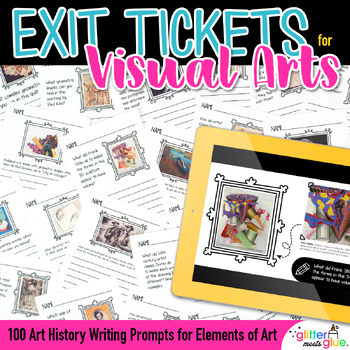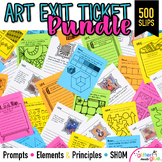Elements of Art History Exit Tickets & PowerPoints for Formative Art Assessment
- Zip
- Easel Activity
Also included in
- Never make another art exit slip again! Take back your nights and weekends struggling to come up with bell ringers and exit tickets for your elementary and middle school art curriculum. No more figuring out the perfect ending to your observation lesson. Imagine having 500 drawing and writing promptsPrice $26.99Original Price $30.00Save $3.01
Description
Looking to teach your students about the elements of art through art history? These exit tickets for art class are a great way to expose children to diverse artwork by painters, sculptors, fiber artists, etc.
Need a quick and easy formative assessment tool for your SGO or SLO? Have a scheduled observation and want a way to polish off the end of your art lesson? Check out this comprehensive pack of 100 unique art exit slips. Each targets an element of art found in art history in diverse artworks.
This resource also includes a PowerPoint slide to accompany every art exit ticket! Each features a large image of the entire artwork, a close-up, and the writing prompt.
This assessment tool is designed for students in 2nd grade through 8th grade. If you’re teaching about line, color, shape, texture, value, form, or space, they're also easy to align to any art lesson.
WHY USE ART EXIT TICKETS?
- Practice, reinforce, and respond to artwork, vocabulary, and art concepts
- Touch upon artists and artisans from diverse cultures
- Encourage expository writing and literacy skills
- Collect data for your SGO or SLO assessment
- Easy to align with any state or local curriculum guides
TEACHER DIRECTIONS
There are a couple different ways to use these exit slips for art, whether it be at the end of a lesson or a unit of study.
For example, you could pre-select a ticket and give everyone the same prompt to complete during the last few minutes of class. So, if you're teaching your students about geometric shapes, you might consider selecting the prompt that reads, "Buildings are made with geometric shapes. Which ones did Red Grooms use in 'City of Chicago?'"
Or maybe you've just completed a lesson on forms and you want your students to demonstrate they can apply what they learned. You might want to use the prompt that reads, "What did Frank Stella do to make the forms in this 3D sculpture appear to have volume?"
You could also use an exit slip as a quick way to introduce art history concepts in small doses. This is especially effective for art teachers who have very short class periods.
A fully choice-based art teacher might choose to print out all 100 writing prompts, put them in labeled folders according to the elements of art, and instruct students to select one from a certain folder.
So if on that day your class is focusing on proportion, each student grabs a prompt in that folder. And with the number of prompts given, it's likely that you'll wind up with all types of reflection pieces that are authentic to the learning in your classroom.
Art exit slips are a great way to gauge student learning concepts and assess standards. Each prompt comes 4 to a page. Simply print and go!
YOU WILL RECEIVE
- 7 Non-Editable PDFs (One for Each Elements of Art)
- 7 Non-Editable PowerPoint Slides (One for Each Exit Slip)
ART EXIT TICKET EXAMPLES
Color
- Artist Gertrude Abercrombie painted "Self-Portrait of My Sister" with analogous colors. She was, however, an only child. Who is the subject of the piece and what do the colors suggest about her?
Form
- Why is "Skyscraper Cabinet" by Paul Theodore Frankl considered a geometric form?
Line
- Is "Standing Woman with Cats" by Alexander Calder an example of a blind contour or a regular contour line drawing? How do you know?
Shape
- This is a Navajo weaving. It's made with simple and complex geometric shapes. Can you name them?
Space
- In Joseph Mallord William Turner's dramatic seascape painting, what is the positive space? Negative space?
Texture
- If you could touch this sculpture, what do you think it would feel like?
Value
- What did 18th century artist James Durno do to make each area of the drawing look different? Give examples.
YOU MAY ALSO LIKE
- Studio Habits of Mind Posters
- Elements of Art Exit Tickets
- Art Exit Slips: Aligned to the Studio Habits of Mind
Created by Amie Bentley, © Glitter Meets Glue Designs, LLC







